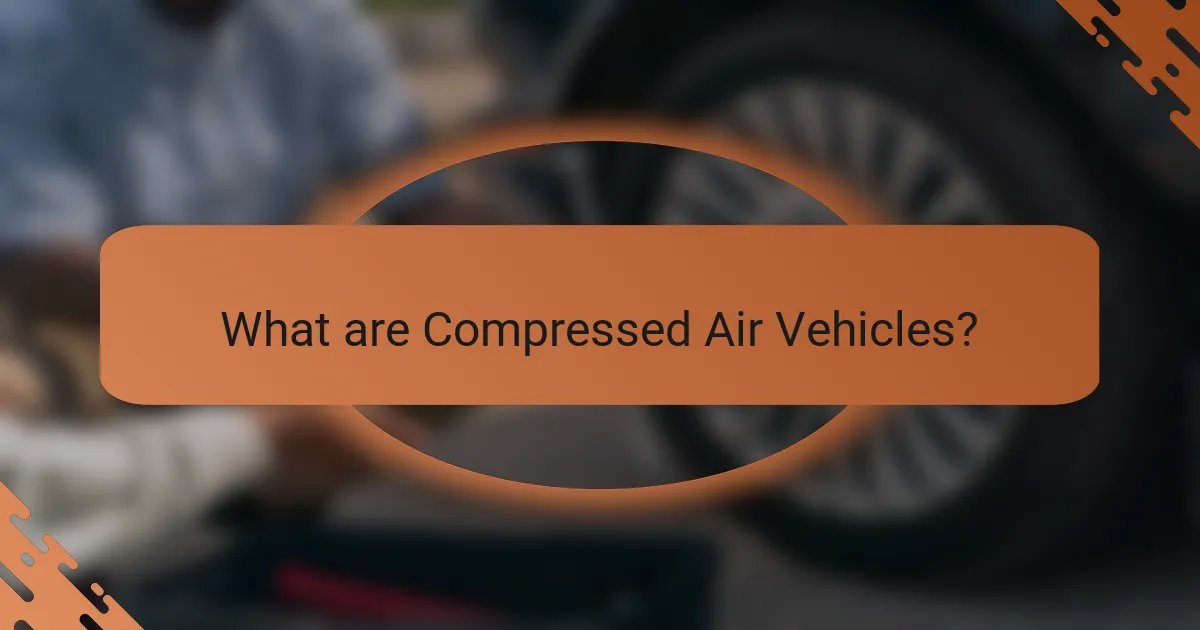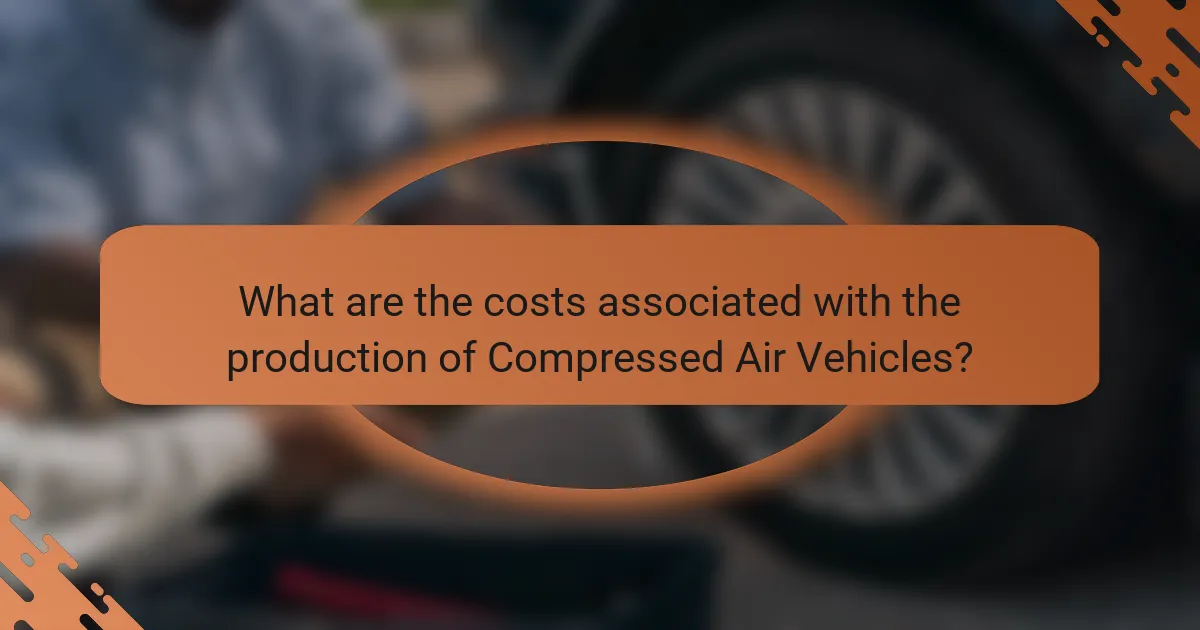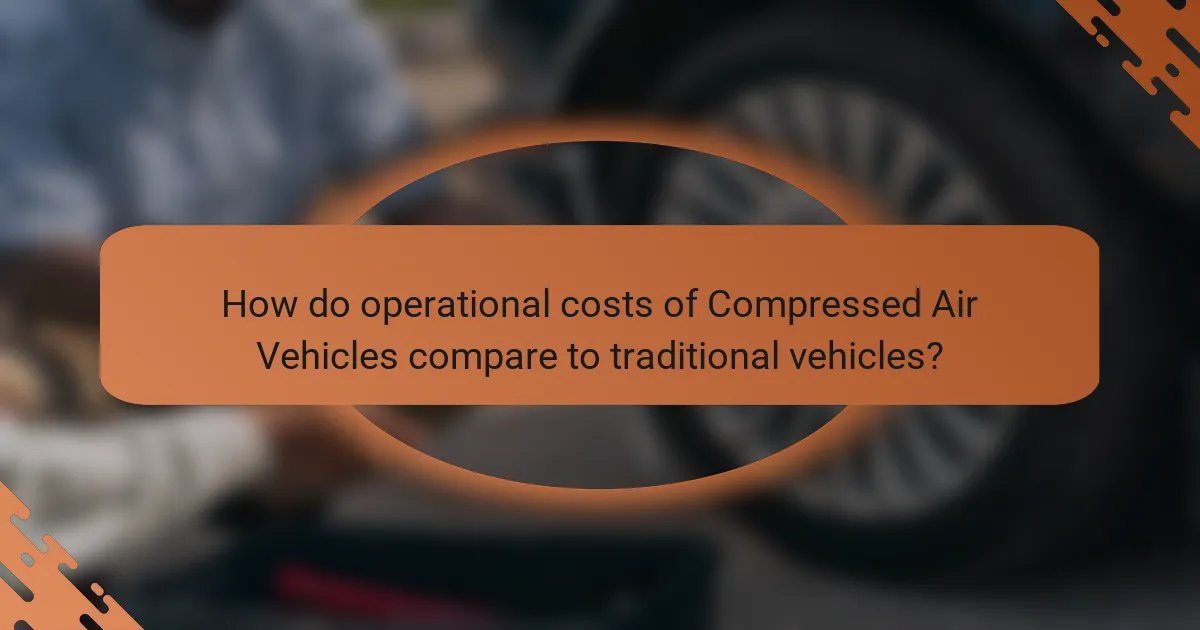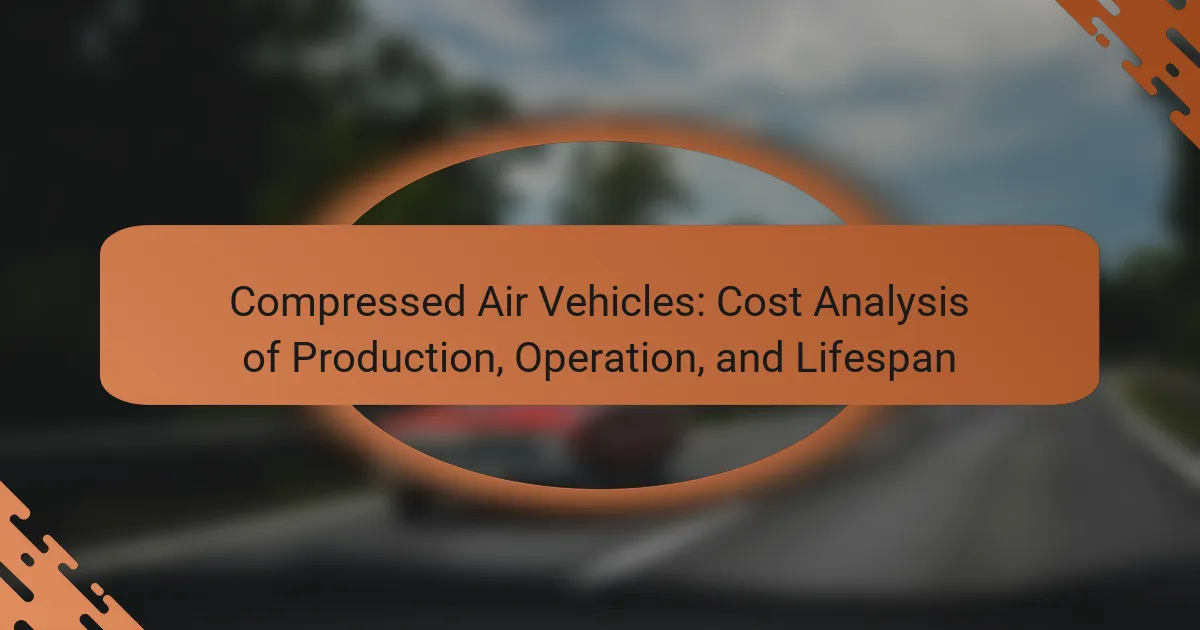Compressed Air Vehicles (CAVs) are innovative vehicles powered by compressed air, utilizing a tank to store air that drives a piston or turbine for motion. This technology promises zero emissions during operation, making CAVs an environmentally friendly alternative to traditional vehicles. The article provides a detailed cost analysis of CAVs, including production costs, which range from $12,000 to $20,000 per unit, and operational costs, which are generally lower than those of gasoline or diesel vehicles. Additionally, it highlights the economic factors influencing the viability of CAVs in the automotive market, including material, manufacturing, and research expenses. The potential for reduced fuel and maintenance costs further positions CAVs as a sustainable and economical option for future urban transportation.

What are Compressed Air Vehicles?
Compressed Air Vehicles (CAVs) are vehicles powered by compressed air as a source of energy. They utilize a tank to store compressed air, which drives a piston or turbine to generate motion. CAVs produce zero emissions during operation, making them environmentally friendly. The technology is still in development, with prototypes demonstrating potential for urban transportation. Companies like MDI and Tata Motors have explored this technology. Compressed air can be generated using renewable energy sources, enhancing sustainability. Research indicates that CAVs could reduce dependence on fossil fuels.
How do Compressed Air Vehicles operate?
Compressed Air Vehicles operate by utilizing compressed air as a source of energy for propulsion. They store air in high-pressure tanks, which is then released to drive pistons or turbines. This process converts the potential energy of compressed air into kinetic energy. The vehicle’s system typically includes a compressor, which fills the tanks, and a mechanism to control the release of air. As the air expands, it pushes against the pistons or turbines, generating motion. These vehicles can be recharged by plugging into a power source to run the compressor. Compressed Air Vehicles are considered environmentally friendly, as they emit no harmful exhaust.
What are the key components of Compressed Air Vehicles?
The key components of compressed air vehicles include the air storage tank, compressor, and propulsion system. The air storage tank holds compressed air at high pressure. The compressor is responsible for compressing ambient air into the storage tank. The propulsion system converts the energy from the compressed air into mechanical energy to drive the vehicle. Additional components may include a pressure regulator to manage air flow and an exhaust system to release used air. These components work together to enable the vehicle to operate efficiently on compressed air.
How is compressed air used for propulsion in these vehicles?
Compressed air is used for propulsion in vehicles by utilizing stored energy to drive pistons or turbines. The compressed air is released from storage tanks into a propulsion system. This release creates a force that moves the vehicle forward. The process is efficient as it converts potential energy into kinetic energy. Compressed air vehicles often employ lightweight materials to enhance performance. These vehicles can achieve significant acceleration due to the rapid expansion of air. Additionally, they produce zero emissions during operation, making them environmentally friendly. Research shows that compressed air propulsion can reduce fuel costs significantly compared to traditional vehicles.
What are the advantages of using Compressed Air Vehicles?
Compressed Air Vehicles (CAVs) offer several advantages. They produce zero emissions during operation, contributing to cleaner air. CAVs utilize compressed air as a power source, which is renewable and abundant. The vehicles are generally quieter than traditional combustion engines, reducing noise pollution. CAVs have lower operational costs due to fewer moving parts compared to internal combustion engines. Maintenance requirements are also reduced, leading to longer vehicle lifespans. Additionally, the use of compressed air can enhance energy efficiency in urban transport systems. These advantages position CAVs as a sustainable alternative in the automotive industry.
How do Compressed Air Vehicles contribute to environmental sustainability?
Compressed Air Vehicles (CAVs) contribute to environmental sustainability by utilizing compressed air as a clean energy source. They produce zero tailpipe emissions, significantly reducing air pollution. CAVs operate without fossil fuels, decreasing reliance on non-renewable energy sources. The use of compressed air minimizes greenhouse gas emissions during operation. Studies show that CAVs can lead to a 30% reduction in overall carbon footprint compared to traditional vehicles. Additionally, they can be powered by renewable energy sources for air compression, enhancing their sustainability. Overall, CAVs offer a viable alternative for reducing environmental impact in transportation.
What are the economic benefits of Compressed Air Vehicles compared to traditional vehicles?
Compressed Air Vehicles (CAVs) offer significant economic benefits compared to traditional vehicles. CAVs typically have lower operating costs due to reduced fuel expenses. Compressed air is less expensive than gasoline or diesel. Maintenance costs are also generally lower for CAVs. They have fewer moving parts, which reduces wear and tear.
In terms of emissions, CAVs can lead to lower environmental compliance costs. Traditional vehicles incur costs related to emissions regulations and potential fines. CAVs do not produce harmful emissions during operation, which can result in savings.
Additionally, CAVs may qualify for government incentives aimed at promoting clean energy vehicles. These incentives can offset initial purchase costs. Overall, the economic advantages of CAVs stem from reduced fuel, maintenance, and regulatory costs compared to traditional vehicles.

What are the costs associated with the production of Compressed Air Vehicles?
The costs associated with the production of Compressed Air Vehicles (CAVs) include material, manufacturing, and research and development expenses. Material costs involve components such as tanks, compressors, and lightweight materials. Manufacturing costs arise from assembly processes and labor. Research and development expenses are incurred for technology advancements and efficiency improvements.
In a study by the International Journal of Vehicle Design, the estimated production cost for CAVs ranges from $12,000 to $20,000 per unit. This price reflects the current market conditions and technology available. Additionally, the cost of specialized equipment for compression and storage adds to the overall production expenses.
These financial factors highlight the economic considerations that influence the viability of CAVs in the automotive market.
How does the manufacturing process impact production costs?
The manufacturing process significantly impacts production costs by influencing material usage, labor efficiency, and overhead expenses. Efficient manufacturing techniques reduce waste and lower material costs. Automation in production can decrease labor costs by increasing output with fewer workers. Additionally, the choice of manufacturing methods, such as additive versus subtractive processes, affects the overall cost structure. For instance, additive manufacturing often requires less material than traditional methods, leading to savings. According to a study by the American Society of Mechanical Engineers, optimized manufacturing processes can reduce costs by up to 30%. This demonstrates the direct correlation between manufacturing efficiency and production expenses.
What materials are commonly used in the production of Compressed Air Vehicles?
Compressed Air Vehicles are commonly produced using materials such as aluminum, carbon fiber, and composite materials. Aluminum is favored for its lightweight and durability, making it ideal for vehicle frames. Carbon fiber offers high strength-to-weight ratios, enhancing performance and efficiency. Composite materials are utilized for their versatility and ability to withstand high pressures. These materials contribute to the overall efficiency and safety of Compressed Air Vehicles. The use of these materials is supported by industry standards for vehicle construction, ensuring reliability and performance.
How do labor costs affect the overall production expenses?
Labor costs significantly impact overall production expenses. They constitute a major portion of total manufacturing costs. High labor costs can increase the price of goods produced. This can lead to reduced profit margins for manufacturers. Conversely, lower labor costs can decrease production expenses. This may enable companies to offer competitive pricing. According to the National Association of Manufacturers, labor costs account for approximately 20% of total production expenses in the U.S. Thus, fluctuations in labor costs directly influence overall financial performance in manufacturing sectors, including compressed air vehicles.
What factors influence the pricing of Compressed Air Vehicles?
The pricing of Compressed Air Vehicles is influenced by several key factors. These factors include production costs, which encompass materials, manufacturing processes, and labor. The technology used in the vehicle significantly affects pricing as advanced systems may increase costs. Market demand also plays a crucial role; higher demand can lead to increased prices. Regulatory requirements can impose additional costs due to compliance with safety and environmental standards. Research and development expenses contribute to initial pricing, especially for innovative designs. Lastly, competition within the automotive market can drive prices up or down based on similar offerings.
How does research and development contribute to vehicle costs?
Research and development (R&D) significantly contributes to vehicle costs by driving innovation and improving efficiency. R&D investments lead to the creation of advanced technologies that enhance vehicle performance. These advancements often require substantial financial resources for testing and prototyping. For example, developing new materials or propulsion systems can increase initial production costs. Additionally, R&D helps comply with regulatory standards, which can add further expenses. According to a report by the National Research Council, R&D expenditures in the automotive industry can account for 5-10% of total vehicle costs. This investment is crucial for long-term competitiveness and sustainability in the market.
What role do government regulations play in production costs?
Government regulations significantly impact production costs. They establish standards for safety, emissions, and labor practices. Compliance with these regulations often requires investment in technology and processes. This can increase initial production expenses. Regulations can also lead to ongoing costs for monitoring and reporting. Additionally, failure to comply can result in fines or shutdowns, further affecting costs. According to a 2021 report by the National Association of Manufacturers, regulatory compliance costs U.S. manufacturers over $19,000 per employee annually. Thus, government regulations play a crucial role in shaping the financial landscape for production.

How do operational costs of Compressed Air Vehicles compare to traditional vehicles?
Operational costs of Compressed Air Vehicles (CAVs) are generally lower than those of traditional vehicles. CAVs utilize compressed air as a fuel source, which is often cheaper than gasoline or diesel. The cost of electricity to compress air is also relatively low. Maintenance costs for CAVs can be reduced due to fewer moving parts compared to internal combustion engines. Traditional vehicles typically incur higher fuel costs and more frequent maintenance. Studies indicate that CAVs can achieve significant savings in fuel expenses over time. Additionally, CAVs have lower emissions, which may lead to reduced regulatory costs. Overall, CAVs present a more economical option in terms of operational costs compared to traditional vehicles.
What are the key operational expenses for Compressed Air Vehicles?
Key operational expenses for Compressed Air Vehicles include maintenance, energy costs, and insurance. Maintenance involves regular checks and repairs to ensure optimal performance. Energy costs pertain to the electricity or other energy sources required for compressing air. Insurance covers potential liabilities and damages associated with vehicle operation. Additionally, depreciation represents the loss in value over time, impacting overall operational costs. Fueling costs are generally lower compared to traditional vehicles, but still significant. These expenses collectively influence the overall cost-effectiveness of Compressed Air Vehicles.
How does maintenance cost differ for Compressed Air Vehicles?
Maintenance costs for Compressed Air Vehicles (CAVs) are generally lower than traditional internal combustion engine vehicles. CAVs have fewer moving parts, which reduces wear and tear. The absence of oil changes and fewer mechanical components leads to decreased maintenance frequency. Studies indicate that maintenance costs can be up to 30% lower for CAVs compared to gasoline-powered vehicles. Additionally, the simplicity of air compression systems minimizes the need for specialized repairs. These factors contribute to overall cost efficiency in maintenance for CAVs.
What are the fuel costs associated with Compressed Air Vehicles?
The fuel costs associated with Compressed Air Vehicles (CAVs) are primarily linked to the energy required for air compression. Compressing air to the necessary pressure typically requires electricity. The cost of electricity varies by region but averages around $0.13 per kilowatt-hour in the U.S.
CAVs can use about 1.5 to 2.0 kilowatt-hours to compress air for a range of approximately 100 kilometers. This results in fuel costs of about $0.20 to $0.30 per 100 kilometers driven.
In comparison to traditional fuels, CAVs can be more economical. The fuel costs for CAVs are significantly lower than gasoline or diesel vehicles, which average around $3.00 to $4.00 per 100 kilometers.
Thus, the operational fuel costs for CAVs present a cost-effective alternative for consumers.
How does the lifespan of Compressed Air Vehicles affect overall costs?
The lifespan of Compressed Air Vehicles (CAVs) significantly affects overall costs. A longer lifespan reduces the average annual cost of ownership. This is due to the extended period over which the initial investment is amortized. For example, if a CAV lasts 15 years instead of 10, the capital cost per year decreases. Additionally, longer-lasting vehicles typically incur lower maintenance costs. They are designed to withstand wear and tear better than shorter-lived alternatives. Research indicates that CAVs can have a lifespan of up to 20 years with proper maintenance. This durability translates to fewer replacements and lower long-term expenses. Overall, a greater lifespan leads to more favorable cost efficiency in both production and operation.
What factors determine the lifespan of Compressed Air Vehicles?
The lifespan of Compressed Air Vehicles (CAVs) is determined by several key factors. These factors include the quality of materials used in construction, maintenance practices, and design efficiency. High-quality materials enhance durability and resistance to wear and tear. Regular maintenance ensures optimal performance and identifies potential issues early. Efficient design can reduce stress on components, leading to longer operational life. Additionally, the operating environment, such as temperature and humidity, can impact lifespan. Research indicates that vehicles exposed to harsh conditions may experience accelerated degradation. Thus, these factors collectively influence the longevity of Compressed Air Vehicles.
How does depreciation impact the long-term cost analysis?
Depreciation reduces the recorded value of assets over time, impacting long-term cost analysis. It affects the overall financial assessment of compressed air vehicles. As these vehicles age, their value decreases, influencing resale and operational costs. Depreciation allows for tax deductions, which can improve cash flow. Accurate depreciation calculations provide a clearer picture of total ownership costs. This aids in budgeting and forecasting for future expenses. For example, a compressed air vehicle with a high depreciation rate may require more frequent maintenance, adding to costs. Understanding depreciation helps stakeholders make informed investment decisions.
What best practices can enhance the cost-effectiveness of Compressed Air Vehicles?
Implementing regular maintenance enhances the cost-effectiveness of Compressed Air Vehicles. Proper upkeep ensures efficient operation and prolongs vehicle lifespan. Utilizing high-quality components reduces repair costs and improves reliability. Optimizing air compression systems maximizes energy efficiency, lowering operational expenses. Training operators on efficient driving techniques can significantly reduce energy consumption. Utilizing lightweight materials in vehicle design can improve performance and reduce energy costs. Conducting thorough cost-benefit analyses before production helps identify the most economical design choices. These practices collectively contribute to the overall cost-effectiveness of Compressed Air Vehicles.
Compressed Air Vehicles (CAVs) utilize compressed air as a clean energy source for propulsion, offering zero emissions and reduced operational costs compared to traditional vehicles. This article provides a comprehensive cost analysis of CAVs, examining production expenses, including materials and manufacturing processes, as well as operational costs related to maintenance and fuel. It also explores the lifespan of CAVs, factors influencing their longevity, and best practices for enhancing cost-effectiveness. Additionally, the article discusses the economic and environmental benefits of adopting CAV technology in urban transportation systems.
